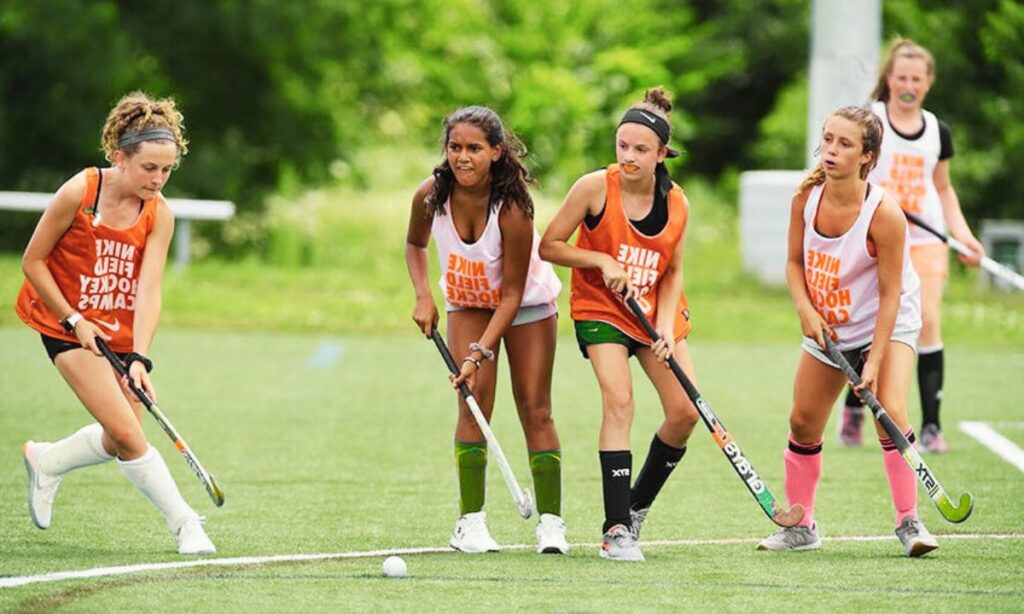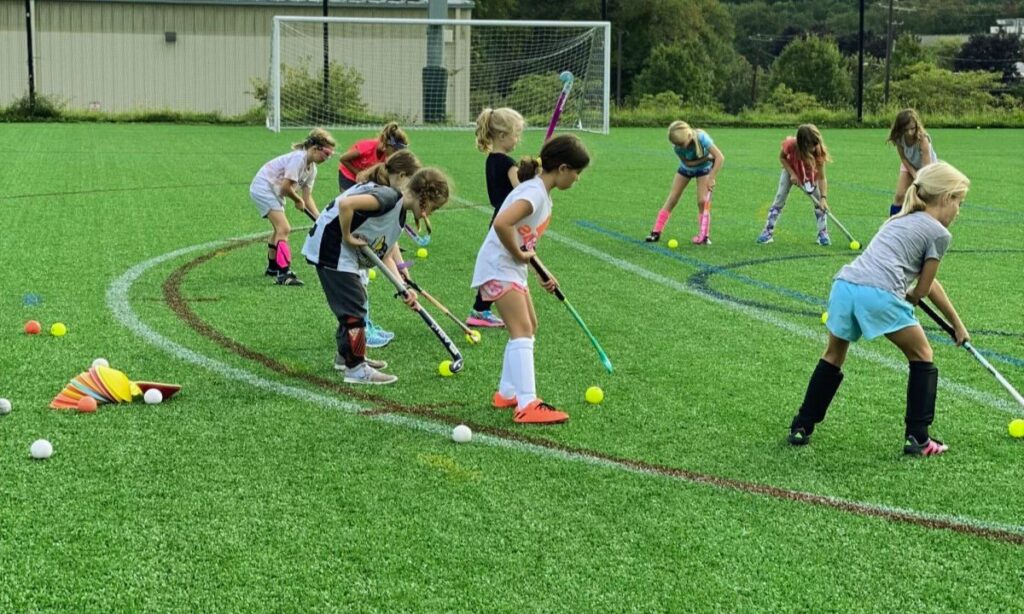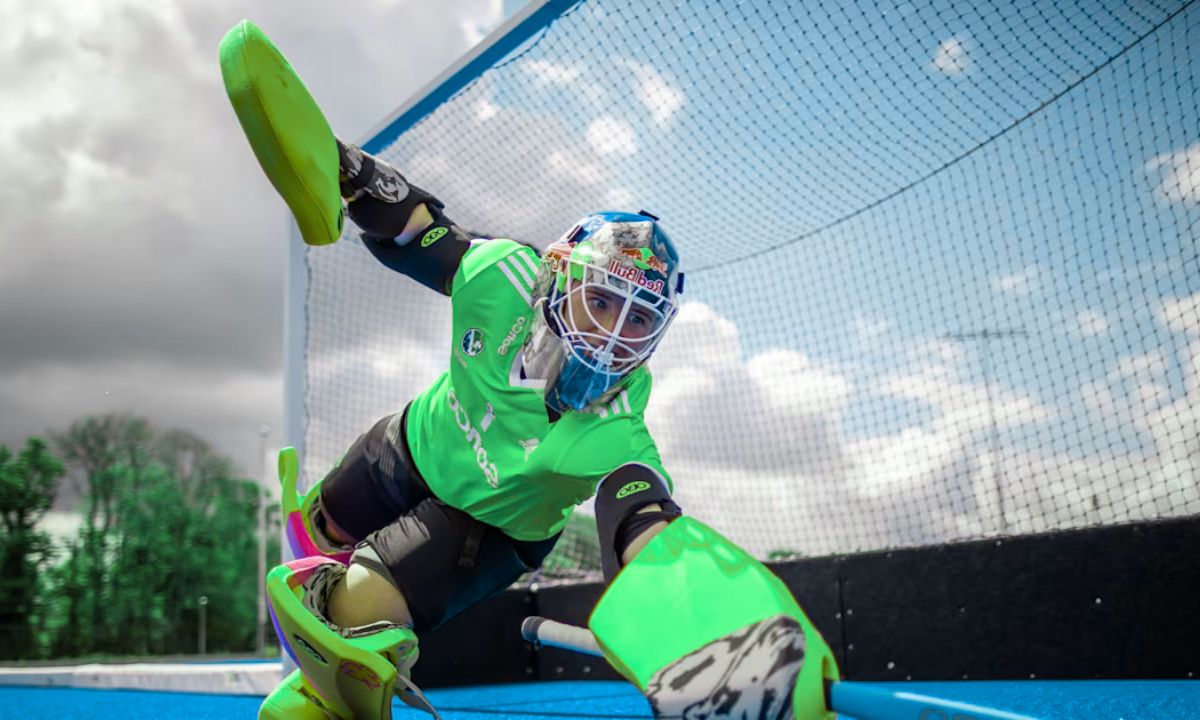Every great hockey player started with the basics. Whether you’re new to the game or brushing up, the basic skills in hockey lay the foundation for everything that happens on the field. Without these core techniques, players struggle with positioning, coordination, and decision-making. Think of these skills as your first set of tools—the more you master them, the better you can build your game. From passing to dribbling, tackling to controlling the ball, these are the cornerstones of confidence and consistency on the pitch.
The Importance of Stick Handling
Stick handling is at the heart of basic skills in hockey. It’s not just about waving the stick around—it’s about learning how to guide the ball smoothly, with control and precision. New players often make the mistake of hitting too hard or not keeping the stick low enough. Good stick handling allows you to dribble past opponents, change direction quickly, and keep possession. Practice simple figure-eight patterns, work on soft touches, and always keep your eyes up. A good stick handler can break through defenses and create opportunities out of nothing.
How to Master Passing in Hockey
Passing is one of the most underrated but essential basic skills in hockey. A strong, accurate pass can change the flow of the game instantly. Whether it’s a short push pass or a sweeping hit across the field, knowing when and how to pass is key. It’s about timing, placement, and reading your teammate’s position. When you practice passing, focus on weight transfer, direction, and communication. Pair up and run drills at different distances. The better your passing gets, the smoother your team plays—and that’s when the game becomes fun.

Receiving the Ball Under Pressure
Receiving is just as important as passing. If you can’t receive the ball properly, it doesn’t matter how good the pass was. Receiving is a subtle but powerful part of the basic skills in hockey. It requires soft hands, good timing, and awareness of space. Cushion the ball with your stick rather than stopping it abruptly. Always be prepared to receive with either the forehand or backhand side. Train to receive passes while moving. In game situations, pressure is constant—so being able to control the ball quickly is a real asset.
Dribbling with Confidence and Control
Dribbling is the art of moving the ball while maintaining possession. It’s one of the more exciting basic skills in hockey, especially when done right. It’s not about flashy moves; it’s about being effective. Keep your stick close, your knees bent, and your body low. Practice dribbling through cones to develop your footwork and coordination. Learn when to go fast and when to slow down. As you improve, try incorporating feints and body swerves. Dribbling lets you drive the play forward—and it gives you the power to control the tempo of the game.
Tackling Without Fouling
Tackling is where defense meets discipline. Among the basic skills in hockey, tackling often separates beginners from more experienced players. A clean tackle disrupts play, regains possession, and keeps momentum in your team’s favor. The key is timing and angle. Don’t swing wildly—approach from the side, keep your stick low, and focus on the ball. Learn the difference between a block tackle and jab tackle. Always aim to intercept or delay, not just smash. Practice helps you stay calm in 1-on-1 situations and make decisive, legal tackles that turn defense into attack.
Understanding Positioning and Movement
You can’t rely on just physical skills—your brain matters too. Understanding positioning is a critical part of basic skills in hockey. It’s about knowing where to be, when to move, and how to support your team. You don’t need to chase the ball all over the field. Smart players anticipate plays, fill space, and move into passing lanes. Work on awareness drills. Talk with your coach about your role and responsibilities. When you move with purpose, you reduce mistakes and increase your impact, even without touching the ball.
Footwork and Agility on the Field
Hockey isn’t played standing still. Good footwork turns you into a more dynamic and effective player. As part of the basic skills in hockey, agility helps you react quickly, change direction, and keep up with fast plays. Practice ladder drills, quick sprints, and sharp turns. Your feet should be as active as your stick. Keep your weight on the balls of your feet and stay low to the ground. Agile players recover faster from mistakes, close gaps quickly, and stay one step ahead of their opponents.
Developing Game Awareness
Even if you have all the physical skills, you won’t get far without game sense. Game awareness means understanding how the match flows—where your teammates are, what the opponents are planning, and what space is open. It’s a soft skill but essential in the list of basic skills in hockey. Watch more games, play different positions, and ask questions. The more you understand the strategy behind hockey, the smarter and quicker your decisions become. It’s what turns a decent player into a dependable one.
The Role of Communication in Team Play
Hockey is a team sport. No matter how skilled you are individually, communication keeps everyone on the same page. Shouting “man on” or “switch” might seem small, but it can prevent turnovers and boost coordination. Strong communication is one of the overlooked basic skills in hockey, yet it can define how your team performs under pressure. Practice talking during drills. Use names, give direction, and keep it short. A quiet team often loses momentum, while a vocal one maintains shape and creates openings even in tough hockey matches.
Practicing Set Plays and Penalty Corners
Set plays give teams structure during high-stakes moments. Penalty corners and free hits require coordination, precision, and repetition. These moments are when teams can capitalize on mistakes, so practicing them is part of mastering basic skills in hockey. Know your role during a penalty corner—whether you’re injecting, stopping, or taking the shot. Focus on timing and positioning. Practice different variations with your team. The more comfortable you are with set plays, the more likely you are to convert chances into goals when the pressure is on.
Using Both Forehand and Backhand Skills
Versatility matters in hockey. Being able to use both forehand and backhand techniques gives you more options and flexibility during play. Whether you’re passing, shooting, or receiving, being skilled on both sides of the stick is part of developing complete basic skills in hockey. Many players rely heavily on their forehand, but good training includes balanced development. Run drills where you alternate sides. It may feel awkward at first, but over time it boosts confidence and gives you more tools to navigate tight spaces and unpredictable plays.
Shooting Techniques and Accuracy
Scoring is one of the most exciting parts of hockey, and solid shooting technique is essential. As a key component of basic skills in hockey, shooting combines balance, timing, and precision. Learn different types of shots—push shots, slap shots, and flicks. Each has its moment. Work on your foot positioning and follow-through. Target specific areas of the goal during drills. Shooting isn’t just about power; it’s about placing the ball where the goalkeeper can’t reach it. Practicing regularly will help you convert opportunities into goals when it matters most.
How Fitness Supports Skill Development
No skill works well without fitness. Hockey is demanding, so strength, endurance, and flexibility play major roles. While not a stick skill, fitness is deeply tied to the effectiveness of basic skills in hockey. Tired players make sloppy passes, miss tackles, and lose focus. Incorporate running, core training, and mobility work into your weekly routine. The fitter you are, the more consistent and reliable your skills become. Think of fitness as the fuel that powers your entire game—it supports recovery, performance, and injury prevention.
How to Build Confidence Through Repetition
One of the best ways to develop the basic skills in hockey is through consistent repetition. Confidence doesn’t just appear—it grows through habit and familiarity. Repeating key drills like passing, trapping, and dribbling helps your muscles remember each motion, even under pressure. The goal isn’t perfection in one session—it’s steady progress over time. Focus on quality over speed during drills. Track your improvement week by week. As your technique improves, your confidence during matches increases. Repetition turns nervous energy into second nature, so that even during the toughest game moments, you feel calm and in control.
Warm-Up Drills to Enhance Skill Execution
Warming up is often overlooked, but it plays a crucial role in preparing your body for executing the basic skills in hockey. A proper warm-up increases blood flow, wakes up your muscles, and reduces the risk of injury. Dynamic stretches followed by light stick-and-ball drills help you transition smoothly into full-intensity play. Spend time jogging, side-stepping, and doing shuttle runs. Then, work on basic ball control and short passes. These routines prepare your hands and feet to respond quickly. A solid warm-up isn’t just about safety—it helps you start the match with sharp focus and energy.
Cool-Down Techniques for Hockey Players
After a hard training session or game, a cool-down is just as important as a warm-up. It helps your body recover and prepares you for the next round of training. Stretching your legs, back, and arms prevents stiffness and maintains flexibility—key for performing basic skills in hockey efficiently over time. Light jogging or walking brings your heart rate down safely. Hydration and breathing exercises also help you reset mentally. Cooling down lets your muscles heal faster, which keeps your core skills consistent and prevents fatigue from affecting future performances. Don’t skip this vital step.
Using Small-Sided Games to Sharpen Skills
Small-sided games—3v3 or 5v5—are perfect for practicing the basic skills in hockey in a real-time, competitive setting. These mini-games give players more touches on the ball, more chances to tackle, and quicker decision-making opportunities. Unlike full-sized matches, there’s less space, which forces sharper passing, tighter control, and faster movement. Coaches love using these because players experience more game-like situations in less time. It’s also fun, which keeps motivation high. Try running short-sided games with specific goals: 2-touch only, left-hand dribbling, or pressure passing. These formats help accelerate growth and develop stronger instincts.
Common Mistakes When Learning Hockey Basics
Many beginners struggle not because of lack of effort, but due to avoidable mistakes. One of the biggest errors is playing with the stick too upright, which limits control and reach. Another is looking down at the ball too often, which reduces awareness. Over-hitting passes or rushing into tackles without positioning also weaken performance. Recognizing these habits is the first step to fixing them. By focusing on small adjustments, you can sharpen the basic skills in hockey quickly. Ask for feedback, film your play, and don’t be afraid to revisit drills. Progress starts by correcting the little things.

Training Alone vs. Team Practice
Practicing alone gives you the chance to focus deeply on specific basic skills in hockey. You can fine-tune your ball control, dribble through cones, or hit targets without any pressure. Solo training builds discipline and reinforces muscle memory. On the other hand, team practice introduces pressure, unpredictability, and communication—things you can’t get alone. Both are important. A good player balances individual work with team drills. Use your solo time to master techniques, and your team sessions to test them in game scenarios. When you combine both, you accelerate your growth and become a more rounded player.
How Weather Affects Hockey Performance
Hockey is often played in different weather conditions, and each can impact how well you perform the basic skills in hockey. In hot weather, you tire faster, which affects your decision-making and reaction time. In the rain, the ball moves differently, requiring better control and foot placement. On colder days, muscles may feel stiff, slowing down dribbling and tackling speed. To perform consistently, adjust your game to the conditions. Warm up thoroughly, stay hydrated, and train in all types of weather whenever possible. Adapting to conditions builds mental toughness and ensures your basic skills don’t disappear under pressure.
Building Mental Toughness Through Hockey Basics
It’s easy to focus on physical training, but mental toughness is just as important when learning the basic skills in hockey. Mistakes will happen. Opponents will pressure you. You’ll miss passes or get tackled. What separates good players is how they respond. Developing a strong mindset helps you stay calm, bounce back quickly, and keep improving. Train your focus by setting short, specific goals in every session. Reflect after games—what went well, what didn’t, and what you learned. Building mental strength makes sure your skills hold up even in stressful moments or tough competitions.
Importance of Proper Gear for Skill Execution
The right equipment enhances how well you perform the basic skills in hockey. A stick that fits your height and grip can dramatically improve ball control. Quality shoes offer traction, helping with speed and balance during dribbling or quick turns. Shin guards, gloves, and comfortable gear boost your confidence and safety, allowing you to focus entirely on playing. Poor-quality or ill-fitting equipment can hold you back, causing discomfort or distraction. Always test your gear before matches, and don’t hesitate to upgrade as you improve. The right gear supports better skill execution and minimizes injury risk.
Setting Goals to Improve Basic Skills in Hockey
Without clear goals, it’s easy to plateau. Setting specific, measurable objectives helps you stay focused on developing the basic skills in hockey. Instead of vague aims like “get better,” choose clear targets: improve passing accuracy by 20%, complete 10 clean tackles per game, or master two dribbling techniques this month. Write your goals down, track progress, and adjust as needed. Celebrate small wins—they keep motivation high. Regular goal-setting turns training into purpose-driven action, and purpose is what drives long-term development. Whether you’re aiming for your school team or national level, structured goals keep your progress on track.
Final Thoughts: Building Strong Foundations for Growth
There’s no shortcut to mastering basic skills in hockey, but every bit of effort pays off. These fundamentals aren’t just for beginners—they remain important throughout your career. The more you refine these core techniques, the more confident, strategic, and composed you become during games. From stick handling to teamwork, everything connects. Take your time, focus on quality over speed, and keep practicing with intention. Whether you dream of playing professionally or just enjoy weekend games, solid basics make every match more enjoyable and rewarding.

